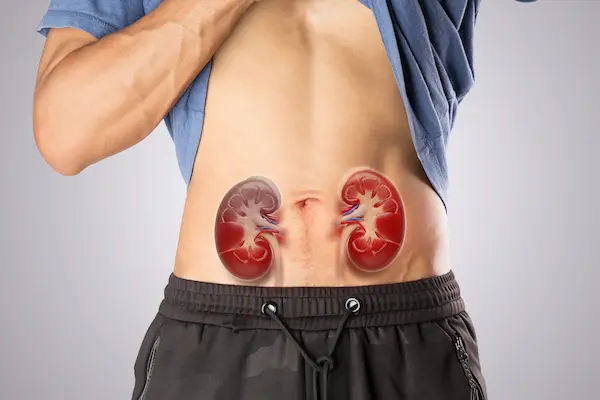Your Guide to the 5 Stages of Chronic Kidney Disease
Know about the 5 stages of chronic kidney disease, what it is, stages in detail, diagnosis, dialysis and more.

_0.webp?tr=q-80,f-webp,w-350,dpr-2,c-at_max 700w)
Introduction
Chronic Kidney Disease (CKD) is a silent but serious condition where the kidneys gradually lose their ability to filter waste and excess fluids from the blood. It often progresses slowly, with few noticeable symptoms in the early stages, making awareness and early detection crucial. Understanding the stages of CKD is the first step toward effective management and slowing its progression. This guide will walk you through the five stages of kidney disease, from early kidney damage to kidney failure, explaining what each stage means for your health. Whether you've been recently diagnosed or are looking to learn more for a loved one, this comprehensive breakdown will empower you with the knowledge needed to navigate this journey.
What is Chronic Kidney Disease (CKD)?
Chronic Kidney Disease is a long-term condition characterised by the gradual loss of kidney function over time. The kidneys are remarkable organs that play a critical role in maintaining overall health. When they are damaged, waste products can build up in the body, leading to a host of complications. It's important to distinguish CKD from an acute kidney injury, which is a sudden drop in kidney function that is often reversible. CKD, on the other hand, is a progressive disease, but its advancement can frequently be slowed down with proper intervention.
Consult a Nephrologist for Personalised Advice
The Kidneys' Vital Role in Your Body
Your kidneys are two bean-shaped organs, each about the size of a fist, located below your rib cage. They are the body's sophisticated filtration system, processing about 200 quarts of blood daily to sift out about 2 quarts of waste and extra water, which becomes urine. Beyond waste removal, they perform these essential functions:
- Regulating Blood Pressure: The kidneys produce hormones that help manage blood pressure.
- Producing Red Blood Cells: They release erythropoietin, a hormone that stimulates bone marrow to create red blood cells.
- Maintaining Bone Health: They convert vitamin D into its active form, which is essential for calcium absorption and bone health.
- Balancing Electrolytes: They keep levels of sodium, potassium, and phosphate in a healthy balance.
How CKD Differs from Acute Kidney Injury
While both involve loss of kidney function, acute kidney injury (AKI) happens suddenly—often within hours or days—usually due to an illness, injury, or toxin. It can be severe but is often treatable, and kidney function may return to normal. CKD, however, is defined as kidney damage or a decreased glomerular filtration rate (GFR) of less than 60 for three months or longer. It's a chronic, irreversible condition, though its progression can be managed.
How is CKD Diagnosed and Staged?
CKD is diagnosed and staged using two simple but critical tests: a blood test and a urine test. These tests help your doctor determine both the level of kidney function and the extent of kidney damage.
Understanding Your eGFR (Estimated Glomerular Filtration Rate)
The eGFR is the most important number for determining your stage of kidney disease. It is calculated from the results of a blood test that measures your creatinine levels (a waste product from muscle metabolism), along with your age, sex, and body size. The eGFR estimates how many millilitres of blood your kidneys can filter per minute. A normal eGFR is 90 or above. As kidney function declines, the eGFR number drops. If your eGFR is consistently below 60 for three months, it is a key indicator of CKD.
The Role of Urine Albumin-to-Creatinine Ratio (ACR)
The ACR test checks your urine for a protein called albumin. Healthy kidneys keep albumin in your blood, but damaged kidneys can leak this protein into your urine. The presence of albuminuria (protein in the urine) is a clear sign of kidney damage. The ACR result helps categorise the stage of CKD and assess the risk of progression, even if your eGFR is still normal.
A Deep Dive into the 5 Stages of CKD
The National Kidney Foundation categorises CKD into five stages based on your eGFR. Here’s what each stage entails.
Stage 1 Kidney Disease: Kidney Damage with Normal Function
- eGFR: 90 or higher
- What it means: You have signs of kidney damage (like protein in urine or physical damage seen on a scan) but still have normal or high kidney function. Many people are unaware they are in Stage 1 as symptoms are rare.
- Action Plan: The goal is to diagnose the cause of damage (e.g., diabetes, high blood pressure) and treat it aggressively. Lifestyle changes are paramount. If you have persistent proteinuria, your doctor may recommend regular monitoring and specific medications.
Stage 2 Kidney Disease: Mild Loss of Function
- eGFR: 60 to 89
- What it means: You have a mild loss of kidney function, along with evidence of kidney damage. Like Stage 1, symptoms are often absent.Action Plan: Continue with the strategies from Stage This includes controlling blood sugar if you have diabetes, managing blood pressure (often with ACE inhibitors or ARBs, which also protect the kidneys), maintaining a healthy diet, and exercising regularly.
Stage 3 Kidney Disease: Moderate Loss of Function
- eGFR: 30 to 59
- What it means: This is often when symptoms may first appear. Kidney function is moderately reduced, and waste products begin to build up in the blood.
- Common symptoms in Stage 3 CKD can include swelling in hands and feet (oedema), back pain, urinating more or less than usual, and fatigue from anaemia.
- Stage 3a vs. 3b: Understanding the Difference
- Stage 3a: eGFR 45-59. A mild to moderate reduction.
- Stage 3b: eGFR 30-44. A moderate to severe reduction.
The risk of complications like cardiovascular disease increases significantly in Stage 3b. Management becomes more intensive, often involving a nephrologist (kidney specialist).
Stage 4 Kidney Disease: Severe Loss of Function
- eGFR: 15 to 29
- What it means: Kidney function is severely reduced. You will likely experience more pronounced symptoms, including fatigue, nausea, vomiting, taste changes, and nerve problems like numbness in toes and fingers.Action Plan: The focus is on slowing progression, treating complications, and preparing for
- kidney failure. This is the time to learn about treatment options like dialysis and transplant. You may be referred for a vascular access evaluation for hemodialysis.
Stage 5 Kidney Disease: Kidney Failure (ESRD)
- eGFR: Less than 15
- What it means: The kidneys have lost nearly all ability to function. This is called End-Stage Renal Disease (ESRD). Waste levels become life-threatening without artificial filtering (dialysis) or a kidney transplant.
- Symptoms: All symptoms from earlier stages can become more severe, and new ones like shortness of breath may emerge.
Dialysis: Hemodialysis vs. Peritoneal Dialysis
- Dialysis performs the function of failed kidneys.
- Hemodialysis: Blood is pumped out of your body to an artificial kidney machine that filters it and returns it to you. It's typically done at a centre 3 times a week.
- Peritoneal Dialysis: The lining of your own abdomen (peritoneum) is used as a filter. A cleansing fluid is pumped into your abdomen, where it absorbs waste before being drained out. This is usually done at home daily.
Kidney Transplant: The Ultimate Goal
A transplant involves surgically placing a healthy kidney from a donor into your body. It is the treatment that offers the best quality of life for eligible patients, though it requires lifelong immunosuppressant medications to prevent rejection.
Conclusion
Receiving a diagnosis of Chronic Kidney Disease can feel overwhelming, but understanding the stages empowers you to become an active participant in your care. While the progression from Stage 1 to Stage 5 may seem like a predetermined path, it is not. With diligent management of underlying conditions, committed lifestyle changes, and regular monitoring, you can dramatically slow the disease's trajectory and maintain a good quality of life for years to come. For personalised advice and ongoing management, consider booking a physical visit to a nephrologist with Apollo24|7 to create a comprehensive care plan tailored to your specific stage and needs.
Consult a Nephrologist for Personalised Advice
Consult a Nephrologist for Personalised Advice

Dr. Archana Chiniwalar
Nephrologist
6 Years • MBBS, MD (Internal Medicine), DM (Nephrology)
Bengaluru
Apollo Medical Center, Marathahalli, Bengaluru

Dr Vinay Kumar A V
Nephrologist
8 Years • MBBS, MD - General Medicine, DM - Nephrology
Bilaspur
Apollo Hospitals Seepat Road, Bilaspur

Dr. Ch. Anil Kumar
Nephrologist
6 Years • MBBS., MD., DM
Kakinada
Apollo Hospitals Surya Rao Peta, Kakinada

Dr. Brijesh Singh
Nephrologist
2 Years • MBBS,MD,DM
Guwahati
Apollo Excelcare Hospital, Guwahati

Dr. Aswini Kumar Panigrahi
Nephrologist
23 Years • MBBS, MD (Int. Med.), DNB Nephro
Hyderabad
Apollo Hospitals Jubilee Hills, Hyderabad
(200+ Patients)
Consult a Nephrologist for Personalised Advice

Dr. Archana Chiniwalar
Nephrologist
6 Years • MBBS, MD (Internal Medicine), DM (Nephrology)
Bengaluru
Apollo Medical Center, Marathahalli, Bengaluru

Dr Vinay Kumar A V
Nephrologist
8 Years • MBBS, MD - General Medicine, DM - Nephrology
Bilaspur
Apollo Hospitals Seepat Road, Bilaspur

Dr. Ch. Anil Kumar
Nephrologist
6 Years • MBBS., MD., DM
Kakinada
Apollo Hospitals Surya Rao Peta, Kakinada

Dr. Brijesh Singh
Nephrologist
2 Years • MBBS,MD,DM
Guwahati
Apollo Excelcare Hospital, Guwahati

Dr. Aswini Kumar Panigrahi
Nephrologist
23 Years • MBBS, MD (Int. Med.), DNB Nephro
Hyderabad
Apollo Hospitals Jubilee Hills, Hyderabad
(200+ Patients)
More articles from Chronic Kidney Disease Ckd Treatment
Frequently Asked Questions
Can you reverse damage in the early stages of kidney disease?
While the scar tissue from kidney damage is permanent, you can often halt the progression and prevent further damage in Stages 1 and 2 by treating the underlying cause (e.g., controlling diabetes and hypertension). This can effectively keep your kidney function stable for many years.
What is the life expectancy for someone with stage 3 kidney disease?
Life expectancy varies greatly depending on age, overall health, and how well the disease is managed. Many people live for decades with Stage 3 CKD, especially if they are diligent with their treatment plan. The key is to slow progression and manage associated risks like heart disease.
What foods should you avoid with kidney disease?
Dietary changes depend on your stage and bloodwork. Common recommendations include limiting:
Sodium: To control blood pressure and fluid retention.
Potassium and Phosphorus: As kidney function declines, these can build up to dangerous levels.
Protein: Reducing protein intake can lessen the kidneys' workload. It's best to work with a renal dietitian for a personalised plan.
How often should I get my kidneys checked?
If you have risk factors like diabetes, high blood pressure, a family history of kidney disease, or are over 60, you should get checked annually. If you have been diagnosed with CKD, your doctor will recommend testing frequency based on your stage—anywhere from every 12 months for stable Stage 1 to every 3 months for Stage 4. Apollo24|7 offers convenient home collection for tests like eGFR and ACR, making regular monitoring easier.
Is feeling tired a sign of kidney disease?
Yes, fatigue and general weakness are very common symptoms, particularly as CKD progresses to Stage 3 and beyond. This is primarily caused by anaemia, a condition where your body doesn't make enough red blood cells, which the kidneys help regulate.
